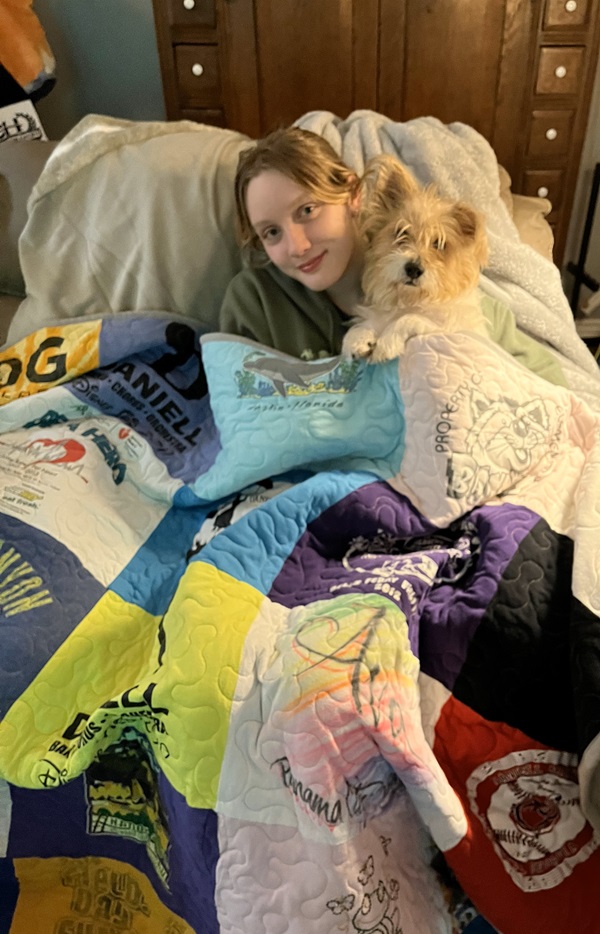Help Finishing your Quilt

Here’s Ava cuddling with her puppy. She knew the quilt was coming. Mom, Tina, had actually started it a long time ago, sewed all of the t-shirts together but needed help finishing it. She had hand sewn “old fashioned” hand ties over the quilt to hold the layers together. She was ok with us removing them in order to long arm quilt it. That’s because for long arm quilting the layers are loaded separately, one at a time on the long arm quilting machine. We added the all over simple quilting, meander, that she picked out and finished the edges with a separate binding in the same fabric that she used for the back.
In the end, Mom was glad it was done and daughter Ava “loves her quilt” – a graduation present.
You may have a similar need. There can often be more to finishing a t-shirt quilt than is anticipated at the outset. It seems simple enough. After all we all have tons of t-shirts, right! What could possibly go wrong?
Congratulations if you’ve tackled making your own t-shirt quilt and got this far or completed it. One of the most challenging parts to making your own t-shirt quilt even for a simple design like this is working with the actual t-shirts.
T-shirts are knits or often have a knit content. You may have some that are 100% polyester or some that are a blend of different fabrics. The challenge with knits is that as soon as you cut the shirt the edges curl. Now how do you sew shirt edges together that are curled. It’s not impossible; but, without interfacing, more time is needed to pin and straighten the edges all the way around the shirt before sewing and before long arm quilting.
What is interfacing? It’s a special fabric that is either sewn or ironed on to the t-shirt fabric to keep the edges nice and straight. We like t-shirts because they stretch and have some “give” with our activities. However, when you cut them to make something else out of them like a quilt, that stretch that we otherwise like can make you want to cuss!
If you’re making a t-shirt quilt, consider what’s important – spending the time to cut, pin and straighten each shirt before sewing them together or spending the time, plus the expense of interfacing to end up with a nice straight edge for sewing and no curls. Your choice. Like a lot of things in life, it can boil down to time or money! Tina’s quilt didn’t have interfacing, so we did the heavy lifting wrestling with the curls at quilting time.
One of the big advantages of interfacing is that the sewn edges end up nice and straight making for a nice appearance. The drawback is it adds expense to your quilt and more time to sew or iron it on to your t-shirts. There are several weights of interfacing from super light to heavy depending upon the end results that you’d like, light and supple or heavy. If you’re hot natured you may prefer a lighter quilt. If you’re cold natured you may want something heavier. Interfacing, batting, and fabrics choices all come together to make up the weight of a quilt.
Tina had excess fabric from her back, the 3rd layer, and planned to fold down the edges of it to make a “fold-over” binding. A fold over binding is thought to be faster. Not necessarily. If the middle layer, the batting has actually been included, the excess batting has to be trimmed off first. For best appearance, the back of the quilt is trimmed and straighted all the way around before being folded over to the front side to cover the raw edges. After being folded over it’s pinned all the way around through all layers so that it can be sewn. Then it’s sewn. Lots of technicalities to consider to completely finish your own quilt.
There is a lot of pride in finishing everything yourself if you have the time and talent. If you have both, it’s extremely rewarding to be able to say. I did it myself !
A separate finished binding is the professional way to finish a quilt. In this instance it did cost a little more, but we were able to lighten Tina’s load and finish her quilt, professionally, for her daughter’s graduation gift.
Tina was ok with me sharing her story. Otherwise, if you need help, we’re here for you.
No one has to know!


